Related Research Articles

Dalmeny House is a Gothic revival mansion located in an estate close to Dalmeny on the Firth of Forth, to the north-west of Edinburgh, Scotland. It was designed by William Wilkins, and completed in 1817. Dalmeny House is the home of the Earl and Countess of Rosebery. The house was the first in Scotland to be built in the Tudor Revival style. It provided more comfortable accommodation than the former ancestral residence, Barnbougle Castle, which still stands close by. Dalmeny today remains a private house, although it is open to the public during the summer months. The house is protected as a category A listed building, while the grounds are included in the Inventory of Gardens and Designed Landscapes in Scotland.

Methven Castle is a 17th-century house situated east of Methven, in Perth and Kinross, Scotland.
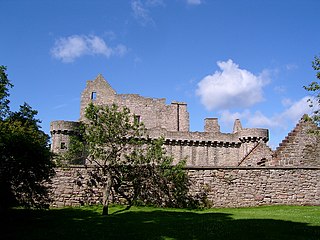
Craigmillar Castle is a ruined medieval castle in Edinburgh, Scotland. It is three miles (4.8 km) south-east of the city centre, on a low hill to the south of the modern suburb of Craigmillar. The Preston family of Craigmillar, the local feudal barons, began building the castle in the late 14th century and building works continued through the 15th and 16th centuries. In 1660, the castle was sold to Sir John Gilmour, Lord President of the Court of Session, who breathed new life into the ageing castle. The Gilmours left Craigmillar in the 18th century for a more modern residence, nearby Inch House, and the castle fell into ruin. It is now in the care of Historic Environment Scotland as a scheduled monument, and is open to the public.
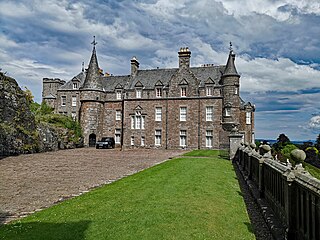
Drummond Castle is located in Perthshire, Scotland. The castle is known for its gardens, described by Historic Environment Scotland as "the best example of formal terraced gardens in Scotland." It is situated in Muthill parish, 4 kilometres (2.5 mi) south of Crieff. The castle comprises a tower house built in the late 15th century, and a 17th-century mansion, both of which were rebuilt in Victorian times. The gardens date to the 1630s, although they too were restructured in the 19th century. The formal gardens are protected as a category A listed building, and are included on the Inventory of Gardens and Designed Landscapes in Scotland. The tower house and mansion are both category B listed.

Blairquhan is a Regency era castle near Maybole in South Ayrshire, Scotland. It was the historic home of the Hunter-Blair Baronets and remained in the family's possession until 2012, when it was sold to a Chinese company.
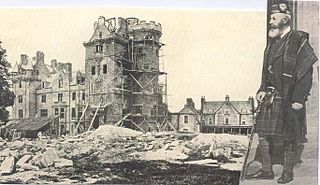
Beaufort Castle or Castle Dounie is a Baronial style mansion built in 1880 and incorporating older building work. It is situated on the right bank of the River Beauly near the town of Beauly in Inverness-shire and is 1 mile (1.6 km) north of Kiltarlity and 13 mi (21 km) west of Inverness. There has been a castle on the site since the 12th century. Beaufort is the traditional seat of the Lords Lovat.

Lauriston Castle is a 16th-century tower house with 19th-century extensions overlooking the Firth of Forth, in Edinburgh, Scotland. It lies on Cramond Road South, between Cramond, Davidson's Mains, and Silverknowes. The substantial grounds, Lauriston Castle Gardens, operate as a local park. The castle was bequeathed to the Edinburgh Corporation and hosts the Lord Provost's annual Garden Party. The house is a Category A listed building and the grounds are included in the Inventory of Gardens and Designed Landscapes in Scotland.
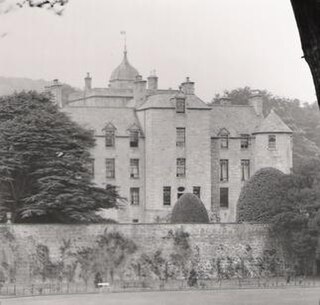
Haltoun House, or Hatton House, was a Scottish baronial mansion set in a park, with extensive estates in the vicinity of Ratho, in the west of Edinburgh City Council area, Scotland. It was formerly in Midlothian, and it was extensively photographed by Country Life in September 1911.

Cambo Estate lies close to the village of Kingsbarns in north-east Fife, Scotland. It is within the East Neuk, 10 kilometres (6.2 mi) south-east of St Andrews. At the heart of the estate lies the 19th-century Cambo House, the home of Sir Peter Erskine, Bt and Lady Catherine Erskine. The gardens of Cambo are open to the public, and include the walled garden and seasonal snowdrop gardens. Elsewhere on the estate is the Kingsbarns Golf Links golf course, which co-hosts the Alfred Dunhill Links Championship every year.

Kinross House is a late 17th-century country house overlooking Loch Leven, near Kinross in Kinross-shire, Scotland. Construction of the house began in 1685, by the architect Sir William Bruce as his own home. It is regarded as one of his finest works, and was called by Daniel Defoe "the most beautiful and regular piece of architecture in Scotland". The builder was Tobias Bauchop of Alloa.
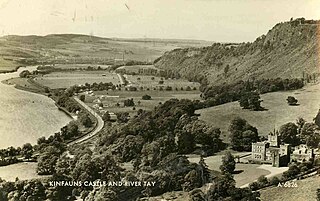
Kinfauns Castle is a 19th-century castle in the Scottish village of Kinfauns, Perth and Kinross. It is in the Castellated Gothic style, with a slight asymmetry typical of Scottish Georgian. It stands on a raised terrace facing south over the River Tay. The house is protected as a category A listed building, and the grounds are included in the Inventory of Gardens and Designed Landscapes in Scotland.
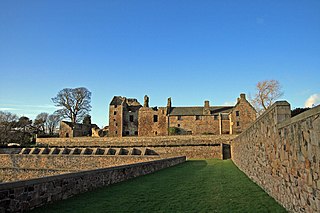
Aberdour Castle is in the village of Easter Aberdour, Fife, Scotland. Parts of the castle date from around 1200, making Aberdour one of the two oldest datable standing castles in Scotland, along with Castle Sween in Argyll, which was built at around the same time.

Dalzell House is a historic house in Motherwell, North Lanarkshire, Scotland. It is located to the south of the town, on the north bank of the River Clyde. At its core is a 15th-century tower house, with extensive additions built during the 17th and 19th centuries. In the 1980s the house was restored and divided for sale as eighteen private apartments, while the surrounding Dalzell estate is now owned by North Lanarkshire Council. The house is protected as a Category A listed building, and the grounds are listed on the Inventory of Gardens and Designed Landscapes in Scotland.
Preston Hall, or Prestonhall, is a late-18th-century mansion in Midlothian, to the south of Edinburgh, Scotland. It is located 1.5 kilometres (0.93 mi) north of Pathhead on the east side of the Tyne Water, opposite Oxenfoord Castle on the west side. The house, together with several estate buildings, are the work of architect Robert Mitchell, and are protected as Category A listed buildings, the highest level of protection for a historic building in Scotland.

Mertoun House is a country house situated by the River Tweed, 2 miles east of St Boswells in the Scottish Borders. It is home to the Duke of Sutherland. The early 18th-century house is an A listed building, and was designed by Sir William Bruce. The gardens of the house are open to the public, and are included on the Inventory of Gardens and Designed Landscapes in Scotland, the national listing of significant gardens.

Balcarres House lies 1km north of the village of Colinsburgh, in the East Neuk of Fife, in eastern Scotland. It is centred on a mansion built in 1595 by John Lindsay (1552–1598), second son of David, 9th Earl of Crawford. The house became the family seat of the Earl of Crawford. The present house is the result of substantial extensions in the early nineteenth century, using part of a fortune made in India, but preserves much of the original mansion.

Stobo Castle is located at Stobo in the Scottish Borders, in the former county of Peeblesshire. The Manor of Stobo was originally owned by the Balfour family. It became the family seat of the Graham-Montgomery Baronets from 1767. The building of the present castle began in 1805 and was completed in 1811 under the supervision of architects Archibald and James Elliot. It is currently operated as a health spa. The house is protected as a category A listed building, while the grounds are included in the Inventory of Gardens and Designed Landscapes in Scotland, the national listing of significant parks and gardens.

The Glen, also known as Glen House, is an estate and country house in the parish of Traquair, southern Scotland. It is located in the glen of the Quair Water, around 5 kilometres (3 mi) south-west of Innerleithen, and 9 kilometres (5.6 mi) south-east of Peebles, in the Scottish Borders. The estate is recorded from the 13th century, but the present Glen House was built in the mid 19th century. The house is protected as a category A listed building, and the grounds are included in the Inventory of Gardens and Designed Landscapes in Scotland, the national listing of significant gardens. Besides the house, the Temple, stables, and the "Lion Gate" are also category A listed.

Finlaystone House is a mansion and estate in the Inverclyde council area and historic county of Renfrewshire. It lies near the southern bank of the Firth of Clyde, beside the village of Langbank, in the west central Lowlands of Scotland.

The Drum is an 18th-century country house and estate on the outskirts of Edinburgh, Scotland. Located between the Gilmerton and Danderhall areas, The Drum is 4 miles (6.4 km) south-east of the city centre. The Drum was the seat of the Lords Somerville from the later Middle Ages, who built a 16th-century house on the estate. This was replaced in the 1720s with a classical house by William Adam. Sold by Lord Somerville in the early 19th century, the house remains in private hands.
References
- ↑ Herbermann, Charles, ed. (1913). "James Tyrie". Catholic Encyclopedia . Robert Appleton Company.
- ↑ "History". Drumkilbo House.
- 1 2 Historic Environment Scotland. "Drumkilbo (GDL00142)" . Retrieved 1 April 2019.
- 1 2 "Drumkilbo House and Walled Garden, Meigle". British Listed Buildings.
- ↑ Historic Environment Scotland. "Drumkilbo House and walled garden (Category B Listed Building) (LB18335)" . Retrieved 1 April 2019.
- ↑ "Drumkilbo House". Historic Houses Association.
- ↑ "Eggs Drumkilbo". The Old Foodie.